It’s been a while since I’ve done a post about what’s flowering now. Today at the London Wetland Centre I found plenty of flowers, so it seemed like a good time. Most people who go to the Centre come away with photos of ducks, swans or otters, of course I managed to get bees instead!
Red clover is just coming out now and I think this is a common carder bee, the only common UK bumblebee that is mostly brown or ginger. The first time red clover flowers it has too long a flower for a honey bee to collect the nectar, but red clover which has been cut and then grown back has a flower short enough for a honey bee to reach the nectar. Ted Hooper writes in ‘Guide to Bees and Honey‘ (5th ed, 2010) that it flowers from mid July to the end of August – which just shows how much our climate is changing.
Some herbs – always popular with bees – are starting to flower. These little pinky white flowers are thyme.
But what bee is this? I think perhaps an Early bumblebee (Bombus pratorum). This one has a wide yellow band on its thorax, so perhaps a male? The Bumblebee Conservation Trust website says “Early bumblebees are a particularly small species and the workers are markedly smaller than other foraging worker species appearing in the springtime. Males have a broad yellow collar that wraps around the thorax, and yellow hair on the face.” Mature nests are small, often with fewer than 100 workers.
This blue star-like plant is borage, a great favourite with bees. Lots of creamy pollen in the baskets. As males don’t have to collect pollen, this must be a female. Another Early bumblebee?
Garlic chives. You can’t see from the photo but bees were all over these, including a magnificently huge and fluffy common Carder bee.
Dog roses are popular with honey bees.
I saw all kinds of bees working the yellow flag irises that lined the watersides.
I didn’t see any bees on these garden poppies but included them anyway because they’re so beautiful.
A pretty impressive insect hotel.
Now, a couple of flowers I’d like help with. I keep seeing these lovely clusters of white flowers everywhere – what are they?
EDIT: Thanks LindyLou and Lucy Garden for identifying this as the UK’s native viburnum, Guelder Rose.
And what about this lollipop-shaped pink one? Thanks!
EDIT: Thanks LindyLou for identifying this as Bistorta officinalis, commonly known as bistort or European bistort.

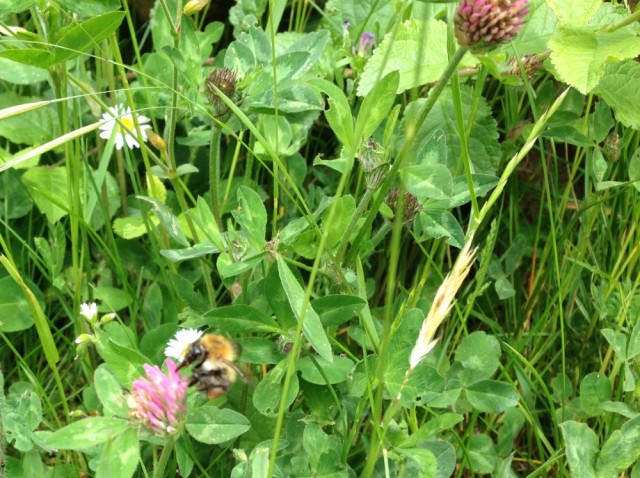
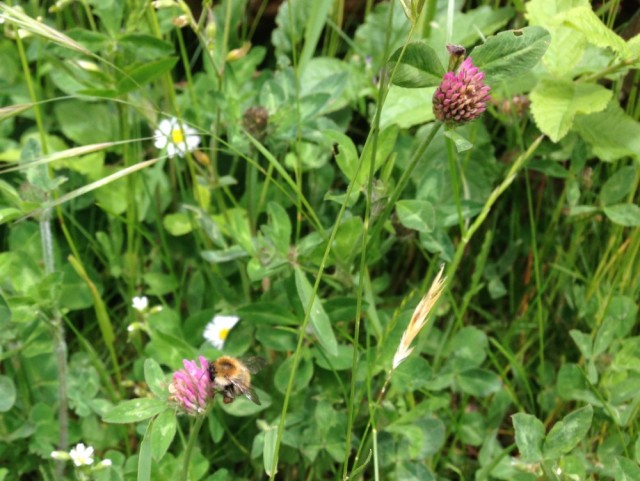


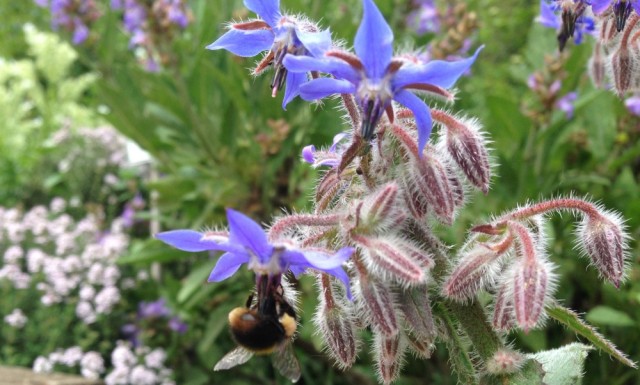


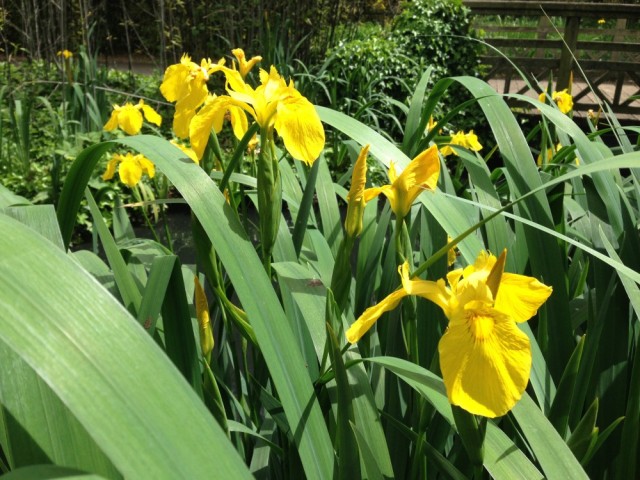
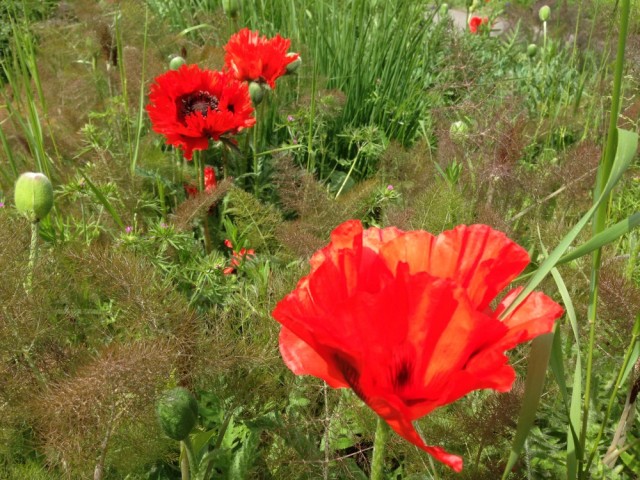

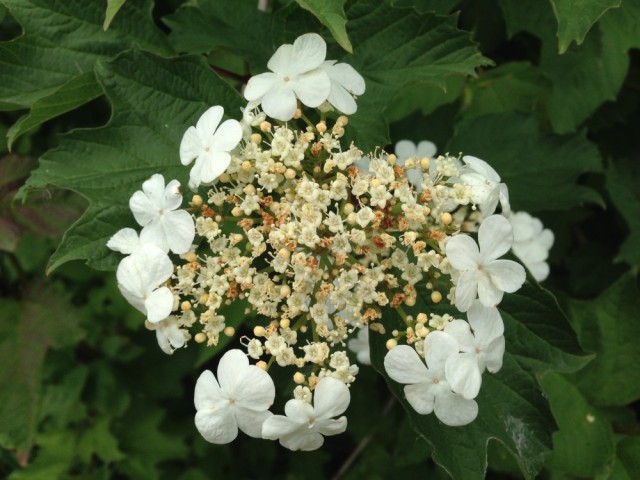
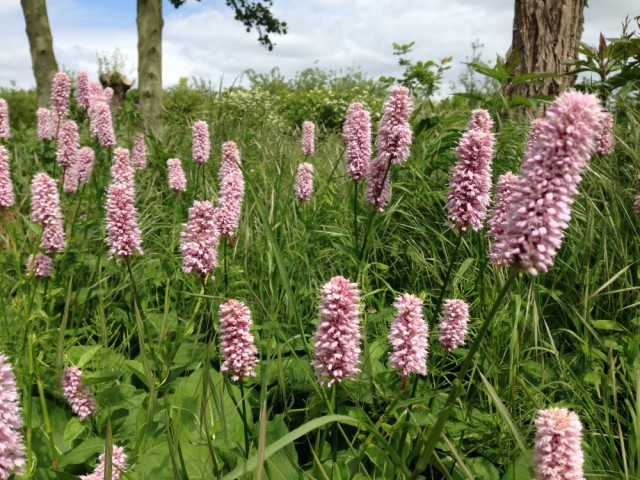
Bistorta officinalis
Bistorta officinalis, commonly known as bistort or European bistort, is a species of flowering plants in the dock family Polygonaceae, previously included in the genera Polygonum or Persicaria. Wikipedia That is the pink one, we call it Adder root. In the park close to my house there are two large patches of it. One gets lots and lots of bees and the other one none. A mystery but I think it has to do with many hours of shadow on the one spot not letting the flower be as productive with its nectar.
Scientific name: Bistorta officinalis
The other one is called Guelder Rose I believe in English. It has powerful healing properties. Bees love it too.
LikeLike
Thanks. Bistorta is not a very pretty name, I prefer your name of Adder root. Your theory about sunshine vs shadow could well be right, there are several flowers that need minimum temperatures to produce nectar.
LikeLike
There are several viburnums that have the same sort of lacecap flowers, which may be why you say you see it around a lot. One, a new form of viburnum plicatum, has just won “plant of the year” at the Chelsea Flower Show. I’ve seen my bees on my more normal plicatum, but not often. The UK native viburnum is indeed Guelder Rose, or viburnum opulus. But viburnum opulus is also the name of the plant that produces gorgeous white, then then green, “snowballs”. So it’s all a bit confusing!
LikeLike
Thank you! Guelder rose – I shall try to remember that.
LikeLike
That is one cool insect hotel, very classy digs. Cute bee pics too loving those flowers.
LikeLiked by 1 person
In my experience, on the first day of a poppy blooming, bees are all over it. I’ve sometimes counted 9 or 10 on the first day…on the second day the number drops waaay down…maybe 3 or 4 bees. On the 3rd day, hardly any. Sometimes I wonder whether we should continue growing them for the bees, but the first day is really worth it, plus, they are colorful highlights in the garden.
LikeLike
Interesting. I believe poppy pollen is a dark blue/black, is that the case with yours?
LikeLike
Lovely photographs! My experience with poppies has been the same as Solarbeez. You have to get up early to get good photographs of bees in poppies. Some of the wild flowers only last a day and the bees dive in early to get the pollen and the stamens become quite tattered although the flowers are fine. Amelia
LikeLike
I have spotted bees on poppies in Albania before, the wildflowers are beautiful there. Here I always seem to be late to find the bees on poppies. Will look out for the tattered stamens instead!
LikeLiked by 1 person
We rescued a nest of Buff Tailed Bumbles this weekend (from someone’s shed) – they are safely tucked under a large flowerpot in the garden now…
LikeLike
Would have liked to see that. Glad they have a safe new home.
LikeLiked by 1 person
Beautiful flowers. And bees, of course. That bug high-rise looks like it could be knocked down by a high wind but I presume it’s fastened together.
LikeLiked by 1 person
It would have to be well fastened – we’ve been lashed by wind and rain recently. There were several like that, but I didn’t spot any inhabitants.
LikeLike
Hi Emily
lovely pics on your blog. Failed module 6 again at 50%. I just wanted to know what reading material you used for module 6 i used the study notes but found there is not enough info in the study notes to cover the questions as some of the 10 marker questions expect you to come up with 10 points and you cannot get 10 points from the study notes. The recommended reading on the BBKA recommneds about 10 books to read. Any ideas or advice would help.
LikeLike
Hi Liam, sorry to hear that. It was a few years ago now, but from looking at the reading list the books I had were Honeybee Democracy, The Buzz about Bees, The Biology of the Honey Bee, The Honey Bee Around and About, The Honey Bee Inside and Out, Guide to Bees and Honey, Plants and Honey bees: Their relationships and Practical beekeeping. Also I used the Mid Bucks notes at http://blog.mbbka.org.uk/category/education/bbka-module-6/ to revise a lot.
I’d bought some of these since I started beekeeping so the cost didn’t seem so bad at the time, I wasn’t buying them all at once! A lot of the older books on the list are really hard to get hold of so I didn’t bother with the out of print ones.
LikeLike
Well that’s a new take on the LWC for me! Lovely photos. I go there to photograph birds (and sometimes to watch the otters), but clearly I’m missing a lot by thinking of it just as a ‘bird place’! RH
LikeLike
The best place was near the Water’s edge cafe, if you follow the path along from that there is a ‘Wetland living’ house with displays of items made from reeds. Outside the house is a little herb garden, where I found most of the bees on flowers like thyme, borage and chives. There were all these serious birders walking around with huge long-distance lenses, while I was crouching down with my little iPhone!
LikeLiked by 1 person
Thanks Emily. I know where you mean. I’ll have a closer look. I am of course intimidated by all those huge long lenses and the proficiency they suggest; and at the same relieved that I only tote something that doesn’t need even a tripod. And in sunlight, I’ve had great results with an iPhone (when I brought the camera but left the battery charging at home!).
LikeLike
Nice pics. They show how far ahead you are in London in terms of flowering, here the borage is just getting ready to flower but we have lots of comfrey which the bumblebees in particular like.
LikeLike
I know what comfrey looks like now, thanks to kind people like you who left me comments on a previous post 🙂
LikeLike
The white flower looks to me like an oakleaf hydrangea. 🙂 xo
LikeLiked by 1 person
Thanks Lindy 🙂
LikeLike
Pingback: Summer loving | My Latin Notebook
I envy you. Pretty much the only flowers in bloom in Newfoundland for my bees are dandelions.
LikeLike
We are lucky to have such a wide variety of flowers in this city and a (fairly) mild climate, even if today’s piercing wind and rain has felt more like November.
LikeLike
The insect hotel is very interesting. I guess the very top one is a bird house?
LikeLike
It looks like it – an odd combo given that birds like to eat bees and bugs! Perhaps it’s actually an elaborate bird home with feeding stations built in!
LikeLike
Very nice pictures. The insect hotel was particularly impressive. On another topic, I stumbled onto
this: http://www.beegym.co.uk/index.html have you heard of it? It’s made by a UK beekeeper, you may be more familiar with it than I. Intriguing to say the least.
LikeLike
Thanks Anna. I have seen one of them but have not seen it in action in a hive. I think it probably helps a bit and is nice to have in a hive but will not get the results a treatment like Apiguard or oxalic acid does.
LikeLike
A lovely collection of flowers and bees. Thanks for the info about the Wetlands Centre too-it’s perfectly timely for me as I’m staying near Hammersmith with my daughter (who’s expecting a baby anytime now) and am in dire need of a ‘wildlife’ outing! If I get there I’ll check out the little bumbles, but sure you’re right with Early Bumblebee.
LikeLike
Glad to give you the idea! It’s such a peaceful place to go walking. Hope you get to meet your new grandchild soon.
LikeLike